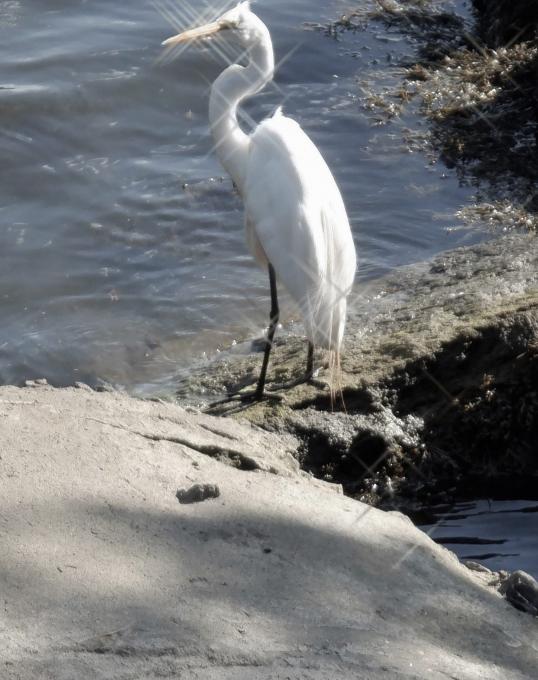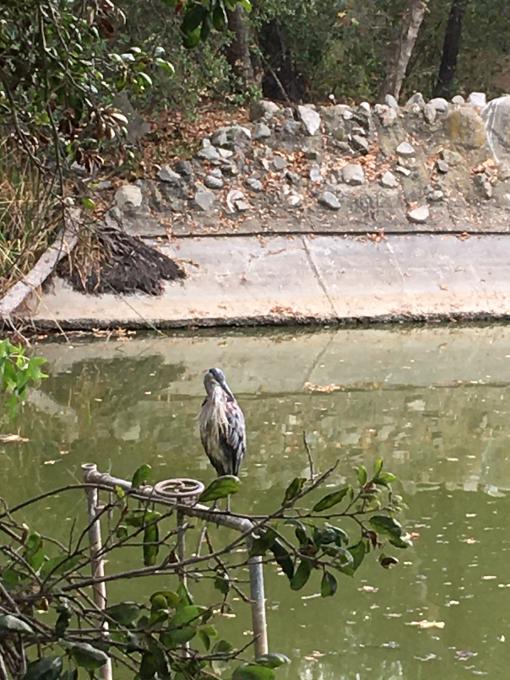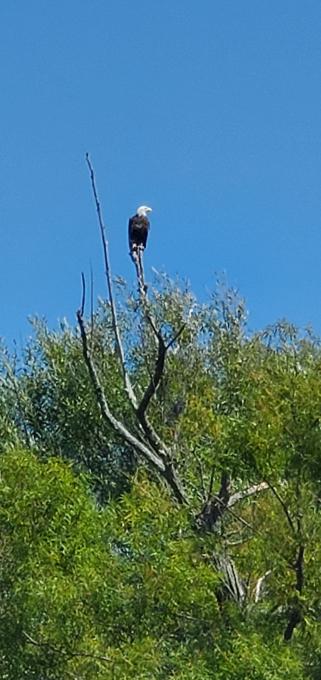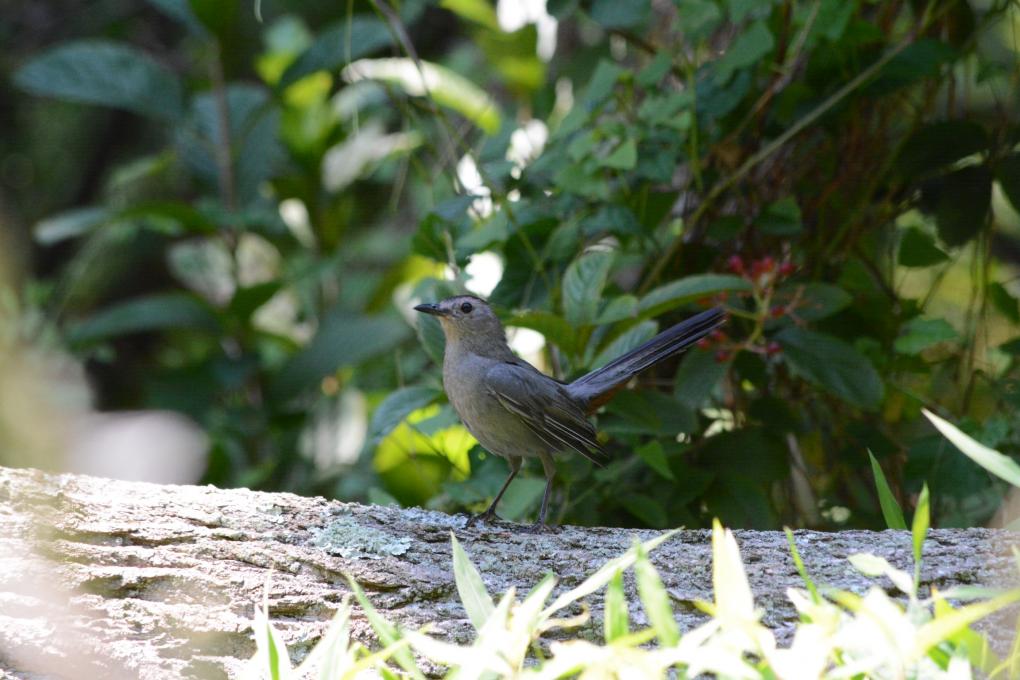The Cornell Lab Bird Academy › Discussion Groups › Joy of Birdwatching › Activities: Local Bird Exploration
-
1. I watched the feeder cam for the first time ever today this am as I knew I had to work later and wouldn't be able to go out, I saw many Blue Jays, gold finches, a couple downy woodpeckers, possible a hairy as the beak size looked to be a third the size of its head, a red-bellied woodpecker, many black-capped chickadees, a male and female cardinal, and for my first time ever 5 tufted titmouse, I live in Oregon so have never seen one of those and used Merlin to ID it. Does it count as a life lister if I saw it on a bird cam from my living room 3000 miles away? Haha not sure. 2. The likely birds are pretty much the birds that I have been seeing on a regular basis while birding around Portland. 3. I am having difficulty finding birds that I didn't know would be there in November as I usually look before I go using the apps, but I did discover in two areas that I have been birding all summer that the reason I am now seen golden and ruby crowned kinglets is because they aren't there in the summer and they start showing up in October haha so now I know why haha so yea learning:)
-
My husband and I walk in the mornings and take some pictures. Thanks to eBird and the local Bird Watchers Group we were able to identify this Gray Hawk-Juvenile Buteo plagiatus, San José, Costa Rica 7 November 2020.

-
Beautiful! Lucky sighting!
-
-
Preparing my backyard for the Project Feeder Watch this past week.
We have repositioned the feeders and added some pine branches to protect the feeders and are using an old Flexible Flyer Sled to add a ground feeding zone. Also ,used the interactive Cornell Winter Feeding Web site and Bird Notes to redesign our feeding area for location, feeder type, and feed options.
With our first Seasonal Snow and the above changes in place we have observed an abundance of Pine Siskins, Gold Finches, House Finches, along with our Northern Cardinals, Blue Jays, Red breasted Nuthatches, White Breasted NutHatches, House Sparrows , Black -Capped Chickadees, Downy Woodpeckers, Red bellied Woodpecker, Red Winged Blackbirds, Mourning Doves, and our Winter Season favorite , the Dark Eyed Juncos !!
Of course, with all this activity we have had frequent raids from the Coopers Hawks . And the Ground Feeding Zone has been active especially after sunset, with our some of our four legged visitors, skunk and a good looking young 4 point Buck ! -
I watched the Cornell Feeder Cam for a different experience from my normal feeders.
1. I observed mostly mourning doves, and I saw several red-winged blackbirds and starlings. The blackbirds were the most aggressive and even pushed out the northern cardinal that showed up.
2. I definitely spotted a lot of the most like birds today. The coolest was a turkey vulture that landed near my son and I as we were walking. It seemed to be enjoying a meal and didn't want to leave. -
Activity 2: I just positively identified the bird whose beautiful song I have loved hearing every fall and spring for so long but have never 'seen'!!! The golden crowned sparrow! My daughter and I watched some at our feeder just now and were so excited to hear their song with the Merlin ap. It is only during this time of COVID that I have been able to really watch the birds at our feeder and am so thankful for that. We also have the birds by ear class to complete next after the Joy of Birdwatching!
-
I feel like one of the gifts of Covid is stopping to watch nature in my own back yard for the first time, too!
-
-
Activity 2: I scrolled through the list of likely birds for Salt Lake City on Merlin and then went to my favorite birding hotspot. I spotted and was able to ID an American Coot, a pair of Downy Woodpeckers, and a Blue-gray Gnatcatcher. These all got added to my life list in eBird. I listened to the call of the Downy Woodpecker and recognized it as one that I had heard before, but didn't recognize until now.
Activity 3: I looked at the bar chart for the Black-chinned Hummingbird and learned that they will be leaving my area soon. They must migrate to warmer climates for the winter. I see that, according to their bar charts, the Lesser and American Goldfinches stick around my area for the winter. I look forward to still finding them even during the cold winter. -
Activity 1: I went to one of the birding hotspots near my house that was listed on eBird. Used Merlin to ID a Black-capped Chickadee. Still having trouble being able to distinguish between an American and Lesser Goldfinch, though.
-

An, of the 'Crane Order,' Bird. On the north-shore of MA. He probably will go South for the Winter. As far as where ? Northern Georgia ? Is a Snowy Egret a 'must migrate' bird ? -
Activity 1 - I have watched the 'Hairy Woodpecker.' Whom was pecking on some surfaces that were not trees. He was pecking at a seeded lawn, and a hole in my garage. He was bigger than a 'Downy Woodpecker,' and it took me a little guesswork to separate him from an 'Acorn Woodpecker.' I did not know the 'Hairy Woodpecker,' was so big. It must have been a big one.
He seem to beak-drum, no matter the surface. And he pecks and drums at everything. Lots of head and beak movements. Also goes from tree, to any surface, with the potential for successful pecking and foraging. Bigger and stronger than I thought.
Activity 2 - I would say, the most likely birds to see this time of year, are the Blue Jays and Cardinals. Because in OCTOBER, in New England, they do not have to migrate. The Canada Goose, you see them flying south, but you still see some of them, for now. I have not seen as many Red Winged Blackbirds, yet I never see them migrate. Do they just disappear ? I just looked it up, they migrate at night. Strange how they are so numerous in natural settings, but unseen as they migrate, and are not seen in industrial settings. Weird. I guess, up until late fall, in the N.E., Cardinals and Blue Jays are still around, and the Canada Goose are leaving in arrow formations. But some are still at grassy patches for now.
Activity 3 - I learned about some birds, that I did not know before. I know Ospreys pass by here, because they like the N.E., and it is part of their path. I did not know the Red Winged Black Bird was such a popular bird. They are everywhere in a nature setting, but seem to avoid rural settings. There seem to be a lot of WaterBirds that are in watery areas, that must go south of the N.E., and start north of the N.E. Because the Herons and Egrets must go to warmer watery locales, when they need to, in the winter. How far south ? By decision or yearly ? I did not know the Arctic Tern travels so far. They pass by the N.E., I would assume, on their way to the Southern areas. S.America, or the wind channel to Europe/Africa. I still am not sure how, and where, non-migrating birds, stay in the dead of winter. I know my bird photography hobby will take a hit in the winter. Unless, I find out where to find, the non-'must' migrating birds. Snowy owl ? Raptors ? Where are you ? -
Activity 1. I used my afternoon sit spot by my water fountain to count birds and submitted my list to ebirds. I have explored the Bird Cam, Merlin, and All about Birds. I have used my field guide mostly to identify birds. I have used the Merlin Explore but have issues when I try to use Merlin in the field, it can’t seem to provide anything. So far I have not been able to get one ID correct or use a picture to ID any species. Sorry, not impressed with Merlin. All About Birds worked well on my phone and on computer. I have been exploring and so far have been successful using except when I need a bird ID because it automatically sends me to Merlin. Seems to have an issue with my location, not sure why it’s not working. Activity 2. The Merlin “Most Likely” works while I am sitting at home but I get all the birds in my town, which includes over 200 birds. I rarely see shore birds at my house even though I am only 3 miles from the beach. Not sure if I can reduce the location in some way to get birds that are most likely to see at home. Activity 3. I have been very impressed with All About Birds and have been able to find 5 birds that pass through my area. All are new species for me this year, Black Turnstone, Black Eyed (Oregon) Junco, Elegant Tern, Snowy Plover, and Least Tern.
Question: Is there a way to get to All About Birds while using the Ebirds app while counting what I see? I have to use a browser to get the web site.
Pat -
Activity 1: I sat on the front porch of our home and observed birds that came to and close to our feeder. Here is the list of birds I saw during my 15 minutes of observations:
Black-capped Chickadee
Mourning Dove
American Robin
American Goldfinch
Pine Warbler
Activity 2: Using Merlin’s “Most Likely” species feature, I was excited to see how accurate this tool is as each of the 5 birds I observed (above in activity 1) were listed as likely ! While I am familiar with each of these species, I followed the instructions and listened to the call and song of each species on Merlin. The Pine Warble is awfully quiet when it calls and it has a very high pitched call that is hard for me to hear.
Activity 3: Using range maps I found five birds that pass through our area, that I knew nothing about !
Eurasian Wigeon (call is loud and "WEE are)
American Wigeon (call sounds like squeezing a childs toy)
Greater Scaup (call sounds like a screw gun)
Lesser Scaup (call sounds like a chicken clucking with a "whoop" like spinning a 45 record backwards)
Clapper Rail (call is kik kik kik)
I went to All About Birds, as well as Merlin to read a little bit about each of them. I listened to each of their calls and songs, and looked at the bar chart to determine which were likely to be in our area the next two months (September and October). -
1. We went to Silver Springs State Park and hiked a trail through sand hills to wetlands and to Silver River. Along the trail we saw red shouldered hawk, Quail, Woodpeckers: red bellied, red headed, and pileated, bluebirds, chickadees, and cardinals. At the river we saw Anhinga sunning themselves.
2. I hadn't used the most likely filter before and discovered most of the birds I see looking out windows or sitting in my backyard: house finch, wrens, chimney swifts, pileated woodpeckers, red bellied woodpeckers, humming birds, American crows and fish crows, bluebirds, downy woodpecker, and white Ibis.
3. I hadn't used the bar charts on ebird before. So helpful. In August we identified 7 Mississippi Kites traveling through. We've heard warblers but they are so difficult to see. The charts and sound recordings really helped us id Northern Parula, great crested flycatcher, and pine warblers. We've heard the whistling ducks fly overhead and observed a Great Egret plucking a lizard out of one of the bushed in our front yard. -
I regularly see white breasted nuthatches, robins, blue jays, house finches, ruby throated hummingbirds, sparrows, and downy woodpeckers. I have suet feeders, hummingbird feeder, and seed feeders. My thistle feeders haven’t seen much action lately but gold finches have been seen previously. I have many squirrels that try to rob my bird feeders. I have a corn stand for them but it doesn’t stop them from stealing bird food.
-
Activity 1 I watched a bird cam at Cornell bird academy and saw 3 blue jays, 2 downy or hairy woodpeckers, a squirrel and a black bird with a long tail and a long curved beak maybe a common grackle or a crow. I also saw a squirrel. Then I went hiking at a county park this evening and saw 2 great blue heron, some northern cardinals,and a blue belted kingfisher that I could I'd. Activity 3 I researched the yellow billed and black billed cuckoos who are here in the summer in wet areas. Their bills and tail colors are different. I looked up the black crowned night heron and yellow crowned night heron--they forage at night and the yellow crowned have a longer neck,legs and a stouter bill-both here in the summer. Wilsons snipe is here in the winter along grassy edges of freshwater ponds or among muddy stubble. Outer tail feathers produce a low pulsing whistle and song is Tikal's Tikal's Tikal's. I didn't think snipe was a real animal or bird.
-
Activity #3: I did not realize that there were so many types of vireos in my area during the summer months: Warbling vireo, Red-eyed vireo & White-eyed vireo! I will be looking and listening for these in the future!
-
Activity 1: I took the below picture. I was visiting a conservation lake area. Suddenly, I heard some rustling and this beautiful Great Blue Heron flew by and then perched on this post. He appeared to be doing some grooming and otherwise did a great job of modeling for all of us that had gathered to see him. He remained there for quite a long time.
-
 A
A -
Activity 1 - I went to a local conservation area. I saw a pileated woodpecker and a mute swan within 15 minutes of arriving there.
Activity 2 - I saw Canada geese, mallards and ring billed gulls - all of which were on Merlin ID's Likely Birds list.
Activity 3 - According to Ebird, the following birds pass through my area at some points throughout the year. While I haven't seen them in person, I have studied them online. In each case, I wasn't aware that these birds passed through my area. They are: Tunda swans pass by my area in late March, early April. Red-eyed vireos pass through from May to December. Sanderlings pass through in September and again in November. Lesser Yellowlegs appear here in August - early November. The Yellow-Billed Cuckoo appear between June and July and again in August - Sept. I'm surprised to see the Tundra swan and Yellow-billed Cuckoo pass through here. One is known for living in the arctic and the other is known for spending its winters in South America. Quite fascinating indeed! -
email just vanishes when I hit submit ?
-
- Activity 1-I have a cylinder bird feeder and a log feeder. Everyday I see an abundance of goldfinches, house finches, northern cardinals, mourning doves, red-bellied woodpeckers, hairy woodpeckers and downy woodpeckers,
- Activity 2-Today I went kayaking on Round Lake, NY and used the Merlin app 'most likely' species for my area today. I saw so many birds from the list including a bald eagle, great blue heron, American Goldfinch and a Red-winged Blackbird. I also saw a double-breasted cormorant which wasn't on the list as well as another bird I couldn't get the Merlin app to identify.



-
Activities 1 and 2: First, I made a list of birds that I could see on a chosen spot (around 45 species), looked at their pictures and listened to their sounds. Then I went to the river mouth at the beach early in the morning, observed birds and took pictures and videos. This was very helpful later at home. For example, I noticed Blackish Oystercatcher only in the pictures. Finally I was able to identify 24 species. I saw some of them for the first time (Andean Flamingo, Blackish Oystercatcher and Black Skimmer). Pictures helped me to identify Kelp and Belcher’s Gulls and it turned out I saw both species in two separate groups. Pictures also helped me with the bird count and I could submit my first checklist in eBird. After my bird watch experience I realized that a pair of binoculars and a stronger camera zoom could be very helpful in the future.
Activity 3: I looked at Bar charts and range maps of locally seen birds in Merlin Bird ID application. Then I looked up for more information online.
Andean Goose: can be seen only in August. It migrates from higher altitudes in the mountains.
Puna Teal: wasn’t spotted locally in March through May and mid-September – mid-October. I read that it’s not migratory, but changes altitude to match the season.
Austral Negrito: disappears in October and appears in April (breeds in Patagonia).
Least Sandpiper: disappears in May, June and July, flies to Alaska and Canada. It can be found at the beach for the most of the year.
Tricolored Heron: Starting mid-October through February reproduces in Peru, can’t be seen locally.
I realized that many birds, like Roseate Spoonbill or Chilean Flamingo live in the highlands all year round. But sometimes they can be spotted in the wetlands in front of the beach. -
Activity 3: I don’t think I’m using the Merlin bar chart feature correctly because all that came up for me were American robin, common grackle, northern cardinal, and house finch. I’ve already seen all those in my back yard.
-
Activity 2: Used Merlin’s “Most Likely” feature and the first five birds on their list for my town are already listed in my birding journal for today (meaning, I’ve already seen them in my back yard) — American goldfinch, gray catbird, mourning dove, blue jay, northern cardinal
-
Activity 1: I keep a birding journal in which I record the species I see each day and other interesting (to me) observational notes. I’ve noticed that there is usually a little flurry around 1:00 or 1:30. When I can, I sit and watch. Today’s flurry featured 2 American goldfinches, a downy woodpecker, a nuthatch, 2 chickadees, and a blue jay. Items of note during the flurry: 1) this is the first time the goldfinches have spent a good amount of time at the feeder, usually they’re here and gone in a flash, 2) this was the first time a chickadee checked out the new bird bath we installed last week, it didn’t drink or bathe, just looked, and 3) the chickadee checked out the bird house which we recently elevated about 3 feet higher than it was before, spending a good amount of time on the perch and popping its head in to look around. For a new birder who just started birdwatching shortly after we moved here in late May, gradually adding feeders and other amenities, all these “firsts” are exciting, as is seeing our guest list growing day by day!
-


I am trying to identify these two birds but so far, have not been successful. The first picture was taken on August 11 in Rye, NY. The second one was taken on July 25 in New Paltz, NY. When I use Merlin, both come up as a Gray Catbird - is that so? Thank you.-
Yes, Gray Catbirds. Nice photos.
-
Read More:


 A
A 



